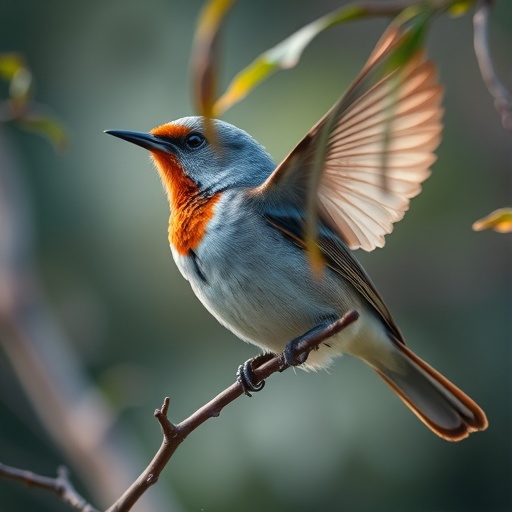In a groundbreaking study published in Environmental Science and Pollution Research, a team of researchers led by M.J. Rainio has unveiled startling insights into the effects of metal exposure on the gut microbiome of young insectivorous passerines. This research sheds light on the precarious balance within ecosystems, where even minute changes can have cascading effects. Understanding how these pollutants impact living organisms at the microbiological level is key to grasping the overall health of our environments.
The study was motivated by an alarming increase in metal pollution across various habitats, particularly those frequented by bird species. Passerines, or perching birds, constitute a vast and diverse group, and their role in the ecosystem as insectivores makes them an important focus for ecological studies. The researchers aimed to dissect how early-life exposure to metals directly influenced the gut microbiome—a critical factor for nutrient absorption and immune response.
Through meticulous sampling, Rainio and colleagues explored the gut microbiota of three insectivorous passerine species. They scrutinized bacteria and other microbes present at different life stages to assess how metal contamination altered microbial communities. Findings revealed significant shifts in microbial composition, indicating that these pollutants might disrupt crucial interactions between host and gut microbiota.
The implications of such findings extend beyond the immediate scope of these birds. The gut microbiome plays a pivotal role in nutrient cycling and energy extraction from food, and disturbances in microbiota began to emerge as potential contributors to altered metabolic health. For instance, changes in microbial diversity were correlated with declines in life-history traits, suggesting that the effects of metal exposure during early development could result in long-term consequences for fitness and survival.
Furthermore, the study highlighted a concerning trend: regions with higher metal contamination exhibited distinct microbiome patterns. This correlation suggests that environmental pollutants not only affect the species directly but also compromise the resilience of microbial communities essential for gastrointestinal health. The evidence points toward a wider ecological phenomenon, where altered microbial interactions may drive declining populations of certain passerine species.
Rainio’s team employed advanced DNA sequencing techniques to unravel the complexities of the gut microbiome. This analytical approach allowed them to quantify shifts in microbial abundance and diversity, leading to richer insights into the ecological ramifications of pollution. By correlating these shifts with observed changes in life-history traits, the researchers painted a vivid picture of the ecological stakes at hand.
Moreover, the work underscores the necessity for preventative measures and pollution management strategies. As anthropogenic influences continue to permeate natural ecosystems, understanding how pollutants impact wildlife can guide conservation efforts. The health of bird populations is becoming increasingly representative of broader environmental health, calling for urgent action to mitigate pollution sources.
Public concern regarding wildlife health is particularly crucial as some passerine species act as bioindicators, reflecting the quality of their habitats. Thus, the findings of this study could have far-reaching implications for conservationists aiming to preserve biodiversity and ecosystem function in the face of ongoing environmental challenges.
Incorporating feedback from ecological stakeholders could result in community-driven initiatives aimed at reducing metal exposure in at-risk habitats. The researchers also advocate for more intensive monitoring of microbiome shifts across different species and locations to better gauge the impact of environmental conditions. Such initiatives will not only bolster our understanding but also catalyze efforts towards smarter resource management.
An unexpected finding during the study was the apparent resilience of some microbiota to metal exposure. While many microbial communities suffered due to heavy metal presence, a portion displayed adaptability, hinting at a diverse genetic background that could aid their survival. This adaptability might hold the key to evolving strategies for improving gut health in wildlife amid persistent environmental stressors.
The parallels drawn between animal health and ecosystem stability in the research serve as a reminder of the interconnectedness inherent in nature. The importance of gut microbiomes in shaping not only individual health but entire ecological networks has been emphasized throughout the study. By connecting pollutant exposure with microbial health, the findings usher in a new era of research centered upon conservation efforts.
Looking forward, the researchers emphasize that further investigations should be directed at various environmental factors. As new studies emerge, building a comprehensive database of microbial responses to diverse pollutants can only deepen our understanding of critical ecological processes. Each stride towards this understanding is essential for fostering resilient ecosystems capable of withstanding human impact.
As we face increasingly pressing environmental issues, this research stands as a clarion call to those vested in the stewardship of nature. It instills hope that through rigorous scientific inquiry and concerted conservation efforts, we can unveil solutions to the pressing challenges posed by pollution and habitat degradation. The future of insectivorous passerines, along with the robust ecosystems they inhabit, rests on our ability to understand and combat these contemporary environmental threats.
This study lays a significant foundation for integrative wildlife management practices that prioritize the health of both organisms and their associated microbiomes. Ultimately, illuminating these complex interactions is not only beneficial for the subjects of this study but acts as a vital framework for addressing broader issues that threaten biodiversity across the globe.
Through this illuminating exploration, Rainio and colleagues not only deepen our understanding of the microbiome’s role in health and disease among passerines but also elucidate the broader implications for ecosystems facing unprecedented challenges from pollution. The hope is that this newfound knowledge will ignite further discussions on proactive measures that can be adopted to ensure the survival of avian species and the health of our planet.
Subject of Research: Metal-induced changes in gut microbial composition and life-history traits in passerines.
Article Title: Metal-induced changes in the early-life gut microbial composition and life-history traits in three insectivorous passerines.
Article References:
Rainio, M.J., Leino, L., Vesterinen, E. et al. Metal-induced changes in the early-life gut microbial composition and life-history traits in three insectivorous passerines.
Environ Sci Pollut Res (2025). https://doi.org/10.1007/s11356-025-37181-x
Image Credits: AI Generated
DOI: https://doi.org/10.1007/s11356-025-37181-x
Keywords: gut microbiome, insectivorous passerines, metal pollution, ecological impact, conservation biology.




